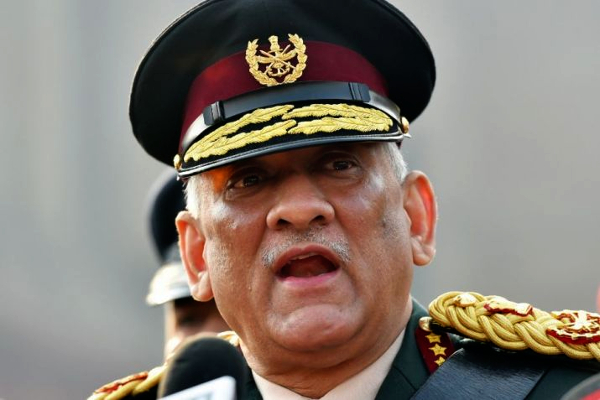From changing the face of United Nations peacekeeping in the Democratic Republic of Congo (DRC) to initiating the biggest exercise to restructure the army to closely supervising India’s two publicly acknowledged surgical strikes on foreign soil, Bipin Rawat, a rare general who does not play golf, brings enormous experience to the table as India’s first Chief of Defence Staff.
Those who have known the 61-year-old general for several decades say Rawat thinks outside the box, takes hard decisions and is not afraid of challenging the status quo.
When Rawat took charge of the UN’s North Kivu Brigade in DRC 11 years ago, things weren’t going too well for the world’s costliest peacekeeping mission, known by its French acronym MONUC. Rawat reworked the velvet-glove strategy to an iron fist within a month of his arrival in 2008, frequently authorising the use of attack helicopters to strafe positions held by rebel groups responsible for recruiting child soldiers, displacing millions of people, and civilian deaths.
Under Rawat’s leadership, the Indian brigade saved a key Congolese province from being overrun by rebels. Lieutenant General Babacar Gaye, the then Force Commander of the UN mission in the Congo, wrote in the commendation awarded to Rawat that it was due to his “leadership, courage and experience” that North Kivu’s capital Goma never fell, the country’s eastern region was stabilised and the main rebel group was forced to come to the negotiating table.
“General Rawat is extremely hardworking and bold in pursuing the organisation’s objectives. He has the ability to think differently and take tough decisions without bothering about the accompanying criticism,” said Lieutenant General BS Sandhu (retd), who has known Rawat for almost 45 years and was his course mate at the Khadakwasla-based National Defence Academy.
Son of a three-star general, Rawat was commissioned into the army in December 1978 after graduating from the Dehradun-based Indian Military Academy where he was awarded the coveted Sword of Honour for exceptional performance. He was commissioned into the 5/11 Gorkha Rifles.
The National Democratic Alliance government superseded two top generals — Lieutenant Generals Praveen Bakshi and PM Hariz — to appoint him army chief exactly three years ago on December 31, 2016. Rawat’s experience in Jammu and Kashmir and the Northeast tipped the scales in his favour.
“General Rawat is the rare amalgam of intellect and hard work. He is extremely upright and fair,” said Lieutenant General Rakesh Sharma (retd), who was Rawat’s commanding officer in the late 1990s. Sharma, who retired as the army’s adjutant general in March 2017, was also the aide-de-camp to Rawat’s father, Lieutenant General LS Rawat, in the early 1980s.
Rawat was closely involved in the planning of the army’s surgical strikes in Myanmar in 2015 followed by targeted operations against terror pads in Pakistan-occupied Kashmir a year later.
In his three-year term as army chief, Rawat courted controversies on several occasions — his recent comments that were widely seen as being aimed at the anti-Citizenship (Amendment) Act protests across India; awarding the Chief of Army Staff’s Commendation card to Major Leetul Gogoi (who bound a Kashmiri civilian to the front of his jeep) and his position on the disability pension.
“He may have courted controversies a few times with his comments but he is an outstanding soldier and military leader. He is very outspoken too. If you ask him a question, he will give you an answer,” said a senior officer, asking not to be named.
General Rawat is the brain behind a mammoth restructuring drill, based on four comprehensive studies led by the army’s topmost generals, which could change the complexion and direction of the 1.2 million- strong Indian Army and transform it into a deadlier fighting machine fully prepared for future wars.
The implementation of the four studies in their totality will reduce troops (by about 100,000), allow the army to tap technological advances in warfare, create integrated brigades that can be mission-deployed swiftly, improve the army’s tooth-to-tail ratio and enhance career prospects for officer and men.
Rawat miraculously survived a chopper accident when he was the commander of the Dimapur-based Headquarters 3 Corps a few years ago.
Source: HT
Image Courtesy: India TV
You may also like
-
IAF Aircraft Set Course For Exercise Eastern Bridge VII At Oman
-
IAF Set To Host The Indian Defence Aviation Exposition-II At Jodhpur
-
Defence Secretary to co-chair 5th India-Philippines Joint Defence Cooperation Committee meeting in Manila
-
Simultaneous Launch Of ‘malpe And Mulki’, Fourth And Fifth Ships Of Asw Swc (Csl) Project
-
Aatmanirbharta in Defence: MoD signs Contract with HAL for 240 AL-31FP Aero Engines for Su-30MKI Aircraft
